
Brassicaceae or Cruciferae is a medium-sized and economically important family of flowering plants commonly known as the mustards, the crucifers, or the cabbage family. Most are herbaceous plants, while some are shrubs. The leaves are simple, lack stipules, and appear alternately on stems or in rosettes. The inflorescences are terminal and lack bracts. The flowers have four free sepals, four free alternating petals, two shorter free stamens and four longer free stamens. The fruit has seeds in rows, divided by a thin wall.

Nasturtium is a genus of a small number of plant species in the family Brassicaceae commonly known as watercress or yellowcress. The best known species are the edible Nasturtium officinale and Nasturtium microphyllum. Nasturtium was previously synonymised with Rorippa, but molecular evidence supports its maintenance as a distinct genus more closely related to Cardamine than to Rorippasensu stricto.
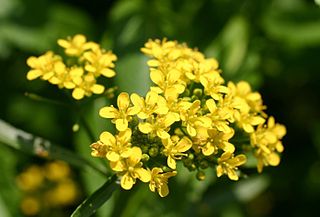
Rorippa is a genus of flowering plants in the family Brassicaceae, native to Europe through central Asia, Africa, and North America. Rorippa species are annual to perennial herbs, usually with yellow flowers and a peppery flavour. They are known commonly as yellowcresses.

Microseris is a genus of plants in the tribe Cichorieae within the family Asteraceae, plants that often called composites. They are native to North America, South America, Australia, and New Zealand.

Sabatia angularis, commonly called rosepink, rose pink, square-stem rose pink or rose gentain is a biennial flowering plant in the Gentianaceae (gentain) family. It is native to central and eastern North America.
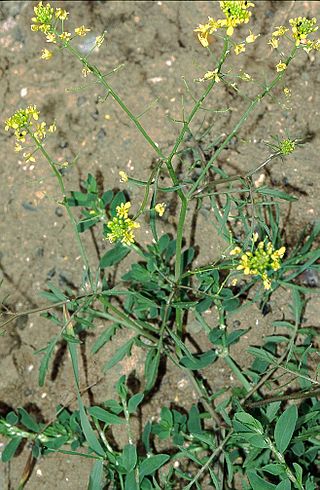
Rorippa sylvestris is an invasive species of plant in the United States, likely entering from Europe before 1818 from ballast water and spreading throughout North America through contaminated nursery seed stock.

Thysanocarpus is a small genus of plants in the family Brassicaceae known generally as fringepods or lacepods. These are small, erect annual herbs. The flat fruit capsule is generally round or oval-shaped with a wing that goes all the way around the pod, giving it a fringed look. The fruits hang from most of the length of the stem. The plants are native to the western United States.

Artemisia biennis is a species of sagebrush known by the common name biennial wormwood. It is a common and widely distributed weed, so well established in many places that its region of origin is difficult to ascertain. This species is most likely native to northwestern North America and naturalized in Western Europe, and eastern and southern North America.
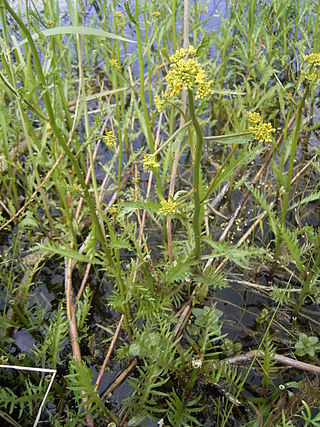
Rorippa amphibia, also known as great yellowcress, is a plant species in the family Brassicaceae. The flowers are visited by many types of insects, and can be characterized by a generalized pollination syndrome.

Rorippa palustris, marsh yellow cress, is a species of flowering plant in the family Brassicaceae. It is widespread and native to parts of Africa, and much of Asia, Europe and Eurasia, North America and the Caribbean. It can also be found in other parts of the world as an introduced species and a common weed, for example, in Australia and South America. It is an adaptable plant which grows in many types of damp, wet, and aquatic habitat. It may be an annual, biennial, or perennial plant, and is variable in appearance as well.

Rorippa austriaca is a species of flowering plant in the family Brassicaceae known by the common names Austrian yellow-cress and Austrian fieldcress. It is native to parts of Europe and Asia, and it is known in North America as an introduced species and sometimes a noxious weed. It can grow in disturbed habitat, such as roadsides, and in very wet habitat such as mudflats. It is a perennial herb growing upright to erect, reaching a maximum height near one meter. The branching stem bears hairless blue-green lance-shaped leaves up to 10 centimeters long. The bases of the upper leaves clasp the stem. The inflorescence is a raceme at the top of the stem and the ends of stem branches. The mustardlike flowers have small yellow petals. The fruit is a plump silique a few millimeters long, but many plants do not fruit and seed production is rare. Reproduction in this species is more often vegetative, the plants concentrating their growth in belowground tissue and spreading clonally. The root system of the plant is particularly aggressive, sending up many new plants as it spreads.
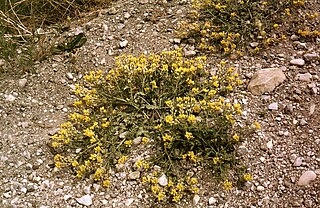
Rorippa columbiae is a species of flowering plant in the family Brassicaceae known by the common names Columbian yellowcress and Columbia yellow cress.
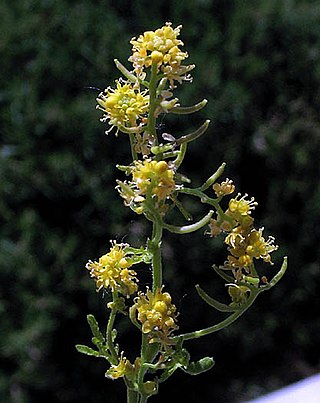
Rorippa curvisiliqua is a species of flowering plant in the family Brassicaceae known by the common name curvepod yellowcress.
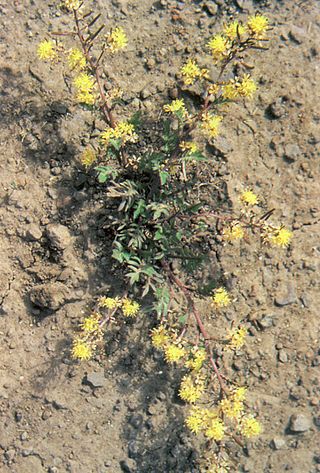
Rorippa sinuata is a species of flowering plant in the family Brassicaceae known by the common name spreading yellowcress. It is native to North America, including most all of the western and central United States, where it grows in many types of moist and wet habitat, such as lakeshores and riverbanks, meadows, and mudflats. It is a perennial herb producing spreading stems up to 40 or 50 centimeters long. It is densely hairy, the hairs rounded like sacs or vesicles. The leaves are up to 8 centimeters long and have blades are deeply toothed, lobed, or divided into smaller leaflets. The inflorescence is an elongated raceme occupying the top portion of the stem containing many tiny yellow flowers just a few millimeters long. The fruit is a curved silique which is variable in size and shape but generally contains many minute seeds.
Rorippa sphaerocarpa is a species of flowering plant in the family Brassicaceae known by the common name roundfruit yellowcress. It is native to North America, including the western United States and northern Mexico, where it grows in moist habitat, such as riverbanks and mudflats. It is an annual herb producing decumbent or erect stems up to 40 centimeters long. The leaves are up to 10 centimeters long and have blades are deeply divided into toothed lobes. The inflorescence is a raceme of mustardlike flowers with yellow petals each no more than a millimeter long. The fruit is a round silique 1 or 2 millimeters wide.

Rorippa subumbellata is a rare species of flowering plant in the family Brassicaceae known by the common names Lake Tahoe yellowcress and Tahoe yellow cress. It is known only from the shores of Lake Tahoe, straddling the border between California and Nevada. There are an estimated fourteen populations of the plant still in existence. It grows only on the direct shoreline of the lake, occupying a seven-foot semi-aquatic zone between the high- and low-tide marks. It is directly impacted by recreational activities on the lake, enduring bombardment by boat wakes, trampling, and construction of docks and other structures.
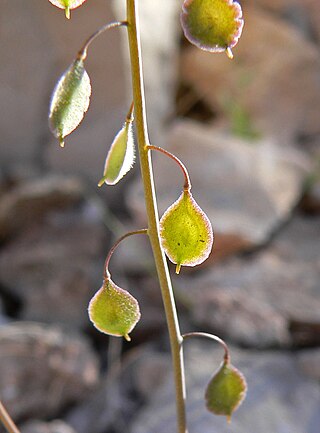
Thysanocarpus curvipes is a species of flowering plant in the family Brassicaceae known by the common names sand fringepod and lacepod. It is native to western North America from British Columbia through the western United States to Baja California, where it grows in many types of habitat. It is a common plant in much of its range. It is variable in appearance. It is an annual herb producing a branching or unbranched stem 10 to 80 centimeters tall. The leaves are mostly lance-shaped but variable. The lower ones are sometimes borne on petioles and the upper ones may clasp the stem at their bases. They may be smooth-edged, toothed, or lobed. The inflorescence is a raceme of flowers with four white or purple-tinged petals and purple sepals. The fruit is a flattened, rounded or oval disclike capsule with a thin wing around the edge. The fruit is under a centimeter long and the wing is variable in appearance, flat or wavy, sometimes perforated.
Rorippa barbareifolia, the hoary yellowcress, is a plant species reported from Manchuria, Inner Mongolia, Mongolia, Siberia, Alaska, Yukon and Saskatchewan. It grows in wet habitats. It can be found along forest borders, in ditches, on stream banks, etc.
Rorippa microtitis, the Chihuahuan yellowcress, is a plant species native to Chihuahua, Arizona and New Mexico. It is widespread in Arizona but has been recorded from only one county in New Mexico (Catron).
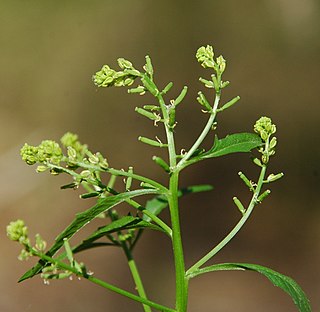
Rorippa sessiliflora, commonly known as stalkless yellowcress, is a species of flowering plant in the family Brassicaceae.


















